COVID-19 Wales situational report: 3 September 2021
Update from the COVID-19 Intelligence Cell and Health Protection Advisory Group.
This file may not be fully accessible.
In this page
COVID-19 situation report summary
Key points to note
Wales moved to Alert Level 0 on 7 August.
Overall cases of COVID-19 and test positivity has increased across Wales. The rate of growth has increased over the past month, with doubling time decreasing from 67 days on 27 July, to 8.6 days on 24 August 2021. We will need to monitor case rates and other key indicators in each nation carefully to better understand the impact of easements of restrictions and return of schools.
The JBC consensus estimate of the reproduction number for Wales is between 1.2 and 1.4 (as at 1 September 2021), while PHW's estimate is between 1.2 and 1.3 (1 September 2021). Note that JBC's estimate is typically lagged by 2-3 weeks while PHW, which uses a different methodology, is lagged by around 1 week. Slide 3, Source: PHW.
Hospital bed and ICU occupancy is increasing rapidly in all health boards across Wales. As at 1 September 2021, there were 383 COVID-19 related patients (Suspected, Confirmed and Recovering) occupying a hospital bed (+74 since previous week), of which 321 were confirmed. There are 44 patients with Suspected or Confirmed COVID-19 in critical care beds in Wales; 120 lower than the maximum COVID-19 position of approximately 164.
In the 7 days up to 25 August 2021, 80 (7.5%) adult care homes in Wales notified CIW of one or more confirmed cases of COVID-19, in staff or residents. This is 26 more notifications than the previous 7 day period and compares to 4 notifications in the 7 days period up to 2 June 2021.
As at 31 August 2021, Wales has had 18,548 confirmed cases of the dominant Delta variant (an increase of 2,096 from the previous week). No other variants of concern were detected in Wales. Data regarding vaccine status of cases and hospitalisations is currently being amended by Public Health Wales and so is not available. Source: PHW.
As at 10pm 1 September 2021, a total of 4,539,655 (+26,926) doses of COVID-19 vaccine were given in Wales and recorded in the COVID-19 Welsh Immunisation System. Of this 2,355,999 (+12,628) were first doses and 2,183,656 (+14,298) were second doses. Source: PHW.
Key indicators
All key indicators have increased since the previous week.
Please note that the arrows represent a change in comparison for the last week.
| Current value (28/08/21) | Change since previous week (21/08/21 to 28/08/21 unless stated otherwise) | ||||
|---|---|---|---|---|---|
| Percentage change | Value change | ||||
| Confirmed case rate (rolling 7 day sum per 100k) | 410 | +23% | ↑ | (+75) | |
| Confirmed case rate for over 60s (rolling 7 day sum per 100k) | 219 | +58% | ↑ | (+80) | |
| Test positivity (7 day RA) | 19.2% | +8% | ↑ | (+1.4 percentage points) | |
| Population estimated to have COVID-19 (prevalence)1 | 0.92% | +11% | ↑ | (+0.09 percentage points) | |
| NHS COVID-19 Admissions2 | 30 | +13% | ↑ | (+3) | |
| ONS deaths (7 day sum)3 | 17 | +55% | ↑ | (+6) | |
| PHW deaths (7 day sum) | 15 | +7% | ↑ | (+1) | |
- Latest COVID Infection Survey data is taken from 22 August 2021 to 28 August 2021.
- Seven day rolling average to the current date of confirmed COVID-19 patients, does not include COVID-19 suspected or recovering.
- Latest ONS deaths data is to 20 August 2021 (rather than 28 August 2021) for the current value. Data to 13 August 2021 is used for the change since previous week.
What is the current status of the epidemic?
| Local Authority | Number | % of All Wales Total | Case Incidence per 100,000 | Change from previous week |
|---|---|---|---|---|
| Swansea | 1615 | 12.5% | 653.9 | 41% ↑ |
| Denbighshire | 504 | 3.9% | 526.7 | 21% ↑ |
| Neath Port Talbot | 839 | 6.5% | 585.4 | 37% ↑ |
| Pembrokeshire | 548 | 4.3% | 435.5 | 17% ↑ |
| Rhondda Cynon Taf | 1148 | 8.9% | 475.8 | 27% ↑ |
| Newport | 609 | 4.7% | 393.7 | 10% ↑ |
| Torfaen | 327 | 2.5% | 348.0 | 2% ↑ |
| Vale of Glamorgan | 467 | 3.6% | 349.6 | 9% ↑ |
| Wrexham | 471 | 3.7% | 346.4 | 10% ↑ |
| Flintshire | 475 | 3.7% | 304.3 | -6% ↓ |
| Conwy | 515 | 4.0% | 439.4 | 37% ↑ |
| Gwynedd | 507 | 3.9% | 407.0 | 37% ↑ |
| Bridgend | 564 | 4.4% | 383.5 | 25% ↑ |
| Carmarthenshire | 736 | 5.7% | 389.9 | 45% ↑ |
| Monmouthshire | 250 | 1.9% | 264.3 | -5% ↓ |
| Powys | 441 | 3.4% | 333.0 | 23% ↑ |
| Ceredigion | 193 | 1.9% | 265.5 | 24% ↑ |
| Cardiff | 1162 | 9.0% | 316.7 | 25% ↑ |
| Caerphilly | 671 | 5.2% | 370.6 | 56% ↑ |
| Isle of Anglesey | 202 | 1.6% | 288.4 | 51% ↑ |
| Merthyr Tydfil | 309 | 2.4% | 512.2 | 153% ↑ |
| Blaenau Gwent | 198 | 1.5% | 283.4 | 61% ↑ |
| Unknown | 81 | 0.6% | - | -31% ↓ |
| Total | 12884 | 100.0% | 408.6 | 27% ↑ |
At a Wales level, on 27 August 2021, the 7-day rolling incidence of COVID-19 cases and percentage of people testing positive for COVID-19 have increased since last week (slide 2).
The JBC consensus Reproduction number (Rt) estimate for Wales is between 1.2 and 1.4 (reported 1 September 2021) , with daily growth rate of between +3% and +7 % and a doubling time between 10 and 20 days. Using PHW positive test data only (more timely data but limited by variation in testing), Rt is estimated to be between 1.2 and 1.3 for Wales (1 September 2021). The central Rt estimate is highest for Swansea Bay and Cwm Taf Morgannwg health boards at 1.4. Source: JBC/PHW.
7-day cumulative case incidence in Wales has increased by 27% to 408.6 per 100,000 population in the last week.
Case incidence is increasing in 20 of the 22 local authorities. Case incidence is above 500 per 100,000 population for four local authorities. Local authorities with the highest case incidences are Swansea and Neath Port Talbot at 653.9 and 585.4 per 100,000 population, respectively.
Case incidence increased in most age groups this week. Although case incidence remains highest in those aged 10-19, case incidence remained steady this week following sharp increases in previous weeks in this age group. Case incidence is highest for the Swansea Bay health board and increased for all health boards in the last week.
The second table below provides estimates of doubling and halving times based on PHW COVID-19 positive test data. In this table, doubling times are positive, whilst halving times are negative. The 95% confidence intervals are showing in brackets after the central estimate. An asterisk (*) means that there are small numbers and estimates should be treated with caution. Local health board level estimates of Rt and halving times will be unstable when incidence is low.
| Area | Rt (cases) | Doubling time (days) |
|---|---|---|
| All Wales | 1.2 (1.2 to 1.3) | 15 (10 to 34) |
| Swansea Bay UHB | 1.4 (1.3 to 1.4) | 9 (60 to 18) |
| CTM UHB | 1.4 (1.3 to 1.4) | 12 (7 to 27) |
| Aneurin Bevan UHB | 1.2 (1.2 to 1.3) | 19 (11 to 62) |
| Cardiff & Vale UHB | 1.2 (1.2 to 1.3) | 18 (11 to 62) |
| Hywel Dda UHB* | 1.3 (1.2 to 1.4) | 12 (7 to 29*) |
| Powys THB* | 1.2 (1.1 to 1.3) | 16 (8 to 264)* |
| Betsi Cadwaladr UHB | 1.2 (1.1 to 1.2) | 23 (14 to 65) |
Cases per 100k (PHW Data) (7 day rolling sum to 27 August)
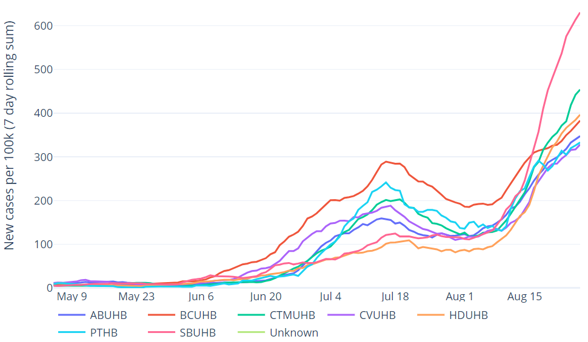
Cases per 100k by age (PHW Data) (7 day rolling sum to 28 August)
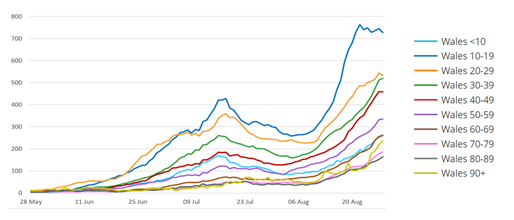
Data as at 12:00PM 1 September 2021 unless otherwise specified.
What is the situation with the NHS and social care?
From early July 2021, COVID-19 pressure on the NHS has been generally increasing. As at 1 September 2021, there were 383 COVID-19 related patients (Suspected, Confirmed and Recovering) occupying a hospital bed. This compares to 309 (74 more occupied beds) on 25 August 2021. Confirmed patients accounted for 321 of the total occupied beds.
There are 44 patients with Suspected or Confirmed COVID-19 in critical care beds in Wales. This is 120 lower than the maximum COVID-19 position of approximately 164. The total number of patients in critical care for both COVID-19 and non-COVID-19 stands at 172, 20 more than the historic maximum critical care capacity of approximately 152.
In the 7 days up to 25 August 2021, 80 (7.5%) adult care homes in Wales notified CIW of one or more confirmed cases of COVID-19, in staff or residents. This is 26 more notifications compared to the 7 days up to 18 August 2021 and compares to 4 notifications in the 7 days up to 2 June 2021, which was the lowest number of notifications since reporting began on 16 December 2020.
Confirmed hospital occupancy (7 day rolling average)

Overall invasive ventilated bed occupancy (7 day rolling average)
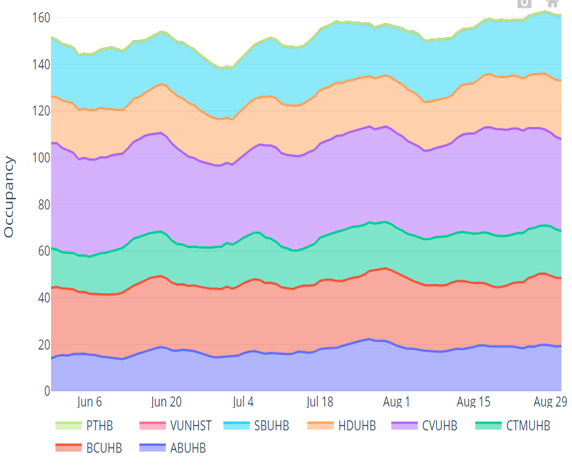
Hospital bed occupancy for suspected and confirmed COVID-19 positive patients (7 day rolling average)
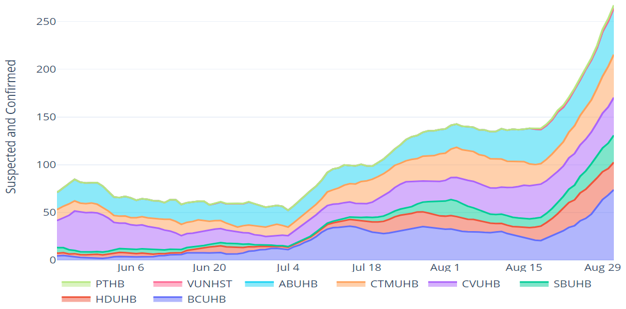
Invasive ventilated bed occupancy for suspected and confirmed COVID-19 positive patients (7 day rolling average)
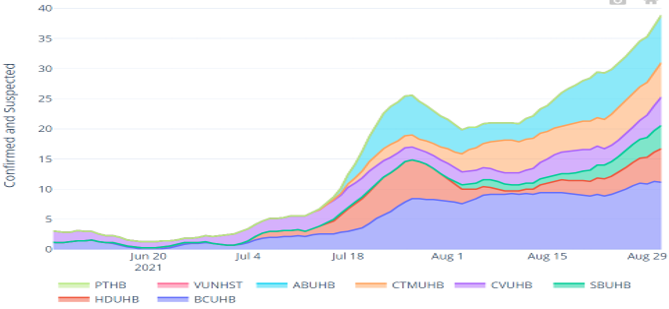
Number of adult care homes reported an ongoing outbreak/incident (last 7 days)

Wastewater Monitoring for COVID-19
In the week ending 29 August 2021, the wastewater signal broadly confirms the national trend in positive COVID-19 cases (PHW) over the same period.
The normalised wastewater SARS-CoV-2 signal across North Wales sites and South Wales sites has been generally increasing over the past 4 weeks, however there has been a slight fall in South Wales in the latest week. Comparing the week ending 29 August 2021 with the previous week, there are still differences between the change in SARS-CoV-2 signal from wastewater data and the change in COVID-19 case incidence data (PHW) over the same time period. (See Table 1)
Wastewater signal is a relatively unbiased indicator because it is not dependent on testing policy and behaviour. The characteristics of the individual sewerage systems could have an impact on the signal being seen. Subsequently, the relationship between cases and wastewater signal is still being investigated.
Sites/regions on the watch-list (increases and/or divergence between SARS-CoV-2 signal and corresponding LSOA PHW COVID-19 case data over the past 2-4 weeks): Chester, Bangor and Wrexham in North Wales; and Cog Moors in South Wales.
Wastewater SARS-CoV-2 signal data below limit of detection recorded as zero. The wastewater data for individual WwTW sites, normalised and unnormalised are inherently noisy. Sampling from Treborth has not been consistent due to construction work at the site, and this has impacted on the North Wales average figures. Wastewater data analysis and reporting is still in a pilot stage and should not be relied upon in isolation.
|
Region |
Site |
16 to 21 August mean |
23 to 29 August mean |
Fold changea Mean normalised SARS-CoV-2 signal |
Fold changea Total reported COVID-19 cases |
|---|---|---|---|---|---|
|
North Wales |
Chester |
0.5 |
3.8 |
8.1 ↑ |
- |
|
North Wales |
Flint |
b |
0.2 |
b |
0.6 ↓ |
|
North Wales |
Ganol |
1 |
0.6 |
0.6 ↓ |
1.4 ↑ |
|
North Wales |
Holyhead |
0 |
0 |
1 |
1.1 ↑ |
|
North Wales |
Kinmel Bay |
b |
b |
b |
0.9 ↓ |
|
North Wales |
Llangefni |
0.1 |
0.1 |
1.1 ↑ |
0.7 ↓ |
|
North Wales |
Treborth |
0.6 |
2.4 |
4.2 ↑ |
0.8 ↓ |
|
North Wales |
Wrexham |
0.3 |
1.4 |
4.3 ↑ |
0.8 ↓ |
|
South Wales |
Cardiff Bay |
15.8 |
16.4 |
1 |
1 |
|
South Wales |
Cog Moors |
5 |
12.3 |
2.5 ↑ |
1 |
|
South Wales |
Gowerton |
19.4 |
32.8 |
1.7 ↑ |
1 |
|
South Wales |
Llanelli Coastal |
5.8 |
8.4 |
1.4 ↑ |
1.3↑ |
|
South Wales |
Llanfoist |
2.1 |
1.8 |
0.9 ↓ |
0.6 ↓ |
|
South Wales |
Merlin's Bridge |
6.6 |
0.3 |
0 ↓ |
1 |
|
South Wales |
Merthyr Mawr |
2.1 |
4 |
1.9 ↑ |
0.9 ↓ |
|
South Wales |
Newport Nash |
12 |
11.5 |
1 |
0.9 ↓ |
|
South Wales |
Parc Y Splotts |
7.1 |
2.3 |
0.3 ↓ |
0.6 ↓ |
|
South Wales |
Ponthir |
36.4 |
8 |
0.2 ↓ |
0.7 ↓ |
|
South Wales |
Swansea Bay |
45.8 |
27.4 |
0.6 ↓ |
1 |
a: The ratio between the measurement from the most recent week (B) and that of the preceding week (A), i.e. B/A
b: Samples not available

Weekly comparison of North and all-Wales mean normalised SARS-CoV-2 signal.
All-Wales mean signal (red line) and North Wales mean signal (blue bars). Data to 29 August 2021.
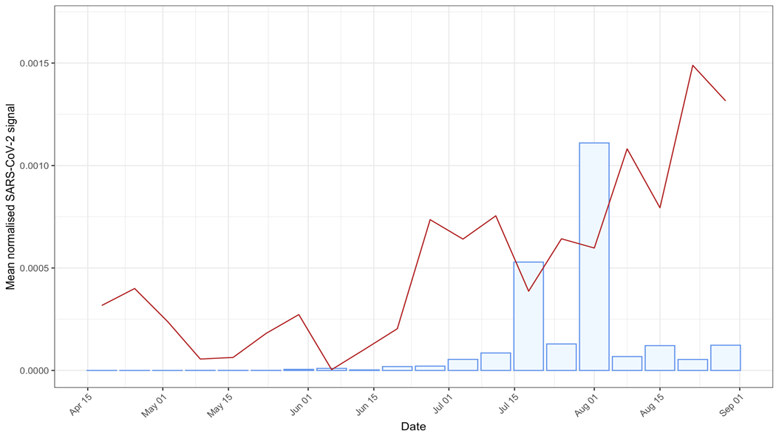
Weekly comparison of South and all-Wales mean normalised SARS-CoV-2 signal.
All-Wales mean signal (red line) and South Wales mean signal (blue bars). Data to 29 August 2021.

What is the situation with arriving travellers?
The greatest number of arrivals are from Spain, although the increase for the week is in line with the overall rise in arrival numbers. There were, however, significant increases in arrivals from France (34.8%) and Italy (41.2%).
17,814 total arrivals for the week (14,928 last week)
- Red: 102 (126 last week)
- Amber: 15,223 (12,430 last week)
- Green: 2,489 (2,372 last week)
The highest numbers of arrivals testing positive on return are from Spain, with 13 to date for the period, with a positivity rate of 0.24% - although this has decreased when comparing to the previous week with 16 testing positive at a rate of 0.35%. Cyprus has seen 7 positives at a rate of 1.54%, but Jamaica (3 positives at 5.6%) and Antigua (2 positives at 6.1%) show the highest positivity rates in countries travelled with 2 or more positive results.
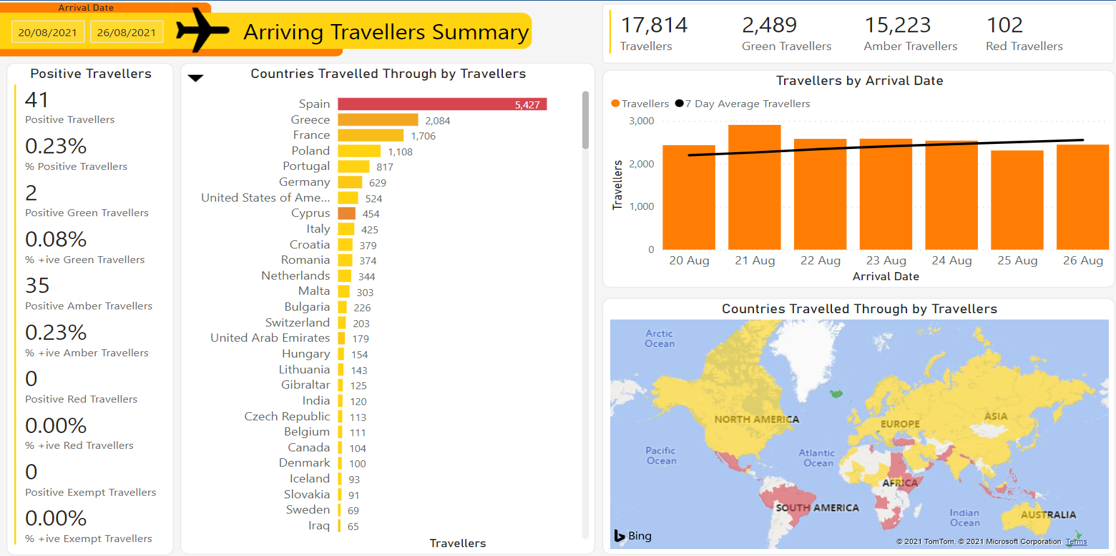


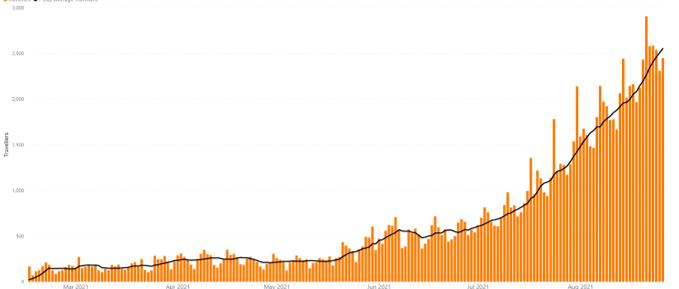
Source: Home Office
Please note that the data provided by the Home Office is derived from Passenger Locator Forms (PLF) which are self-completed by travellers. As such, data may contain inaccuracies. Due to the limitations associated with data capture and legislation, some minor discrepancies may be present in the data. Countries with 10 or less travellers have been included in the overall positive traveler total, but excluded from the Green/Amber/Red positive traveller breakdown totals for personal identifiable information purposes.
Mobility data, adherence and UK comparison
Mobility data by location of trip, Welsh local authorities
The latest mobility data shows increases in the latest week in some categories (eg retail and recreation) compared to the previous week. The baseline for much of the data is during January to February 2020 and changes are relative to that period. It is not possible to determine if mobility is higher/lower than would have been expected prior to the pandemic as data for 2019 or earlier years is not published.
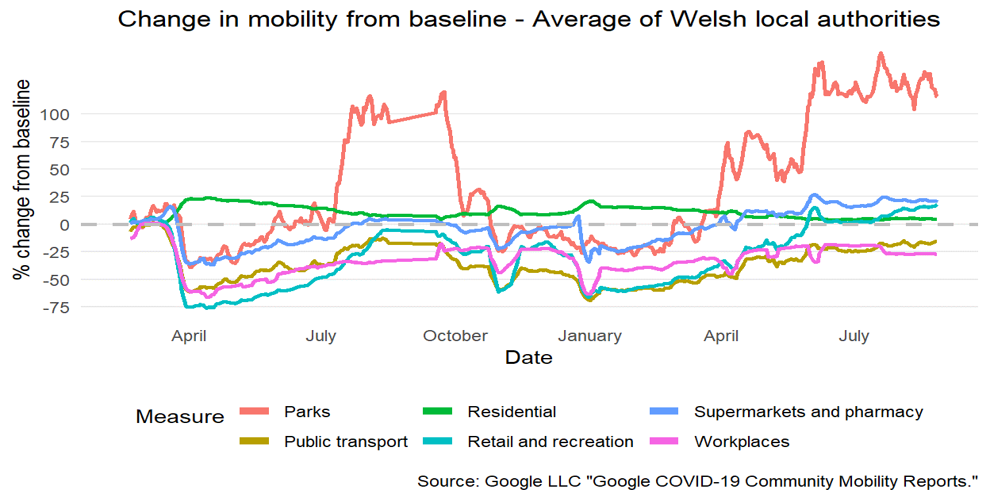
Adherence
The most recent IPSOS MORI data for the period 13 August – 16 August for Wales shows a decrease compared with the last survey wave in those only leaving home for essential trips, while those maintaining 2m social distance remained steady.
Results from the coronavirus (COVID-19) Infection Survey, 22 to 28 August
The percentage of people in the community population testing positive has levelled off in England, increased in Scotland and decreased in Northern Ireland, while the trend is uncertain in Wales. Positivity is highest in Northern Ireland (1.56%) and lowest in Wales (0.92%).
It is estimated that an average of 28,100 people in Wales had COVID-19 (95% credible interval: 20,000 to 38,400), equating to around 1 in 110 people or 0.92% of the community population (up from 0.83% last week). This compares to around 1 in 70 people in England, around 1 in 75 people in Scotland, and around 1 in 65 people in Northern Ireland.
Source: Office for National Statistics COVID-19 Infection Survey.
Positivity rates (%) across UK countries up to 28 August 2021
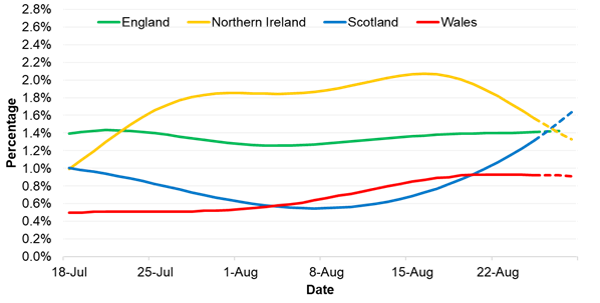
Vaccine and immunity status
Vaccination and antibody status of individuals aged 16 and over in Wales
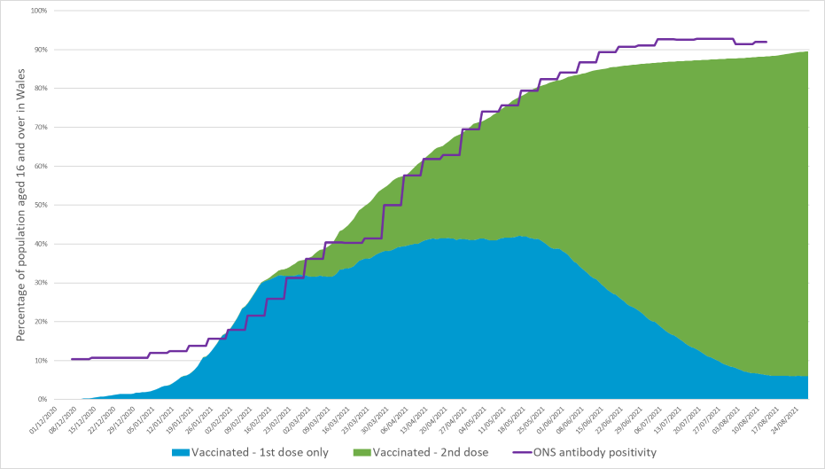
Immunity estimates and antibody status of individuals aged 16 and over in Wales

The COVID-19 vaccination rollout of first and second doses has slowed in Wales. As at 28 August 2021, 89% of people aged 16 and over had received at least one COVID-19 vaccine dose in Wales. 6% of people aged 16 and over had exactly one vaccine dose and 84% were fully vaccinated.
Between 9 and 13 August 2021, the ONS COVID-19 Infection Survey estimated that 92.0% of the community population aged 16 and over in Wales tested positive for COVID-19 antibodies.
As at 28 August 2021, it is estimated that 88% of people aged 16 and over in Wales had some immunity against COVID-19 infection. The lower and higher estimates of immunity are 83% and 91% of people aged 16 and over in Wales. If no vaccines had been administered, it is estimated that 41% of people aged 16 and over would be immune.
It is currently estimated that over 80% (may be closer to 90%) of the population, spread evenly across Wales, must be immune to COVID-19 before population immunity effects would be observed (TAG advice on the Delta variant, published 18 June 2021). Note that the immunity estimate of 88% is for individuals aged 16 and over, not the total Wales population, and varies across age groups.
Differences between antibody presence and immunity estimates include:
- ONS antibody estimates are based on study participants who have volunteered for the study and estimates are extrapolated.
- ONS estimates are based on the 16+ community population, which excludes people in care homes or hospitals. Immunity estimates are based on the whole 16+ Wales population.
- While antibody protection doesn’t equal immunity from infection, it does give a useful indication of the level of protection from infection in the Welsh population.
- Antibody estimates use 2019 mid-year population estimates while the immunity estimates use 2020 mid-year estimates.
Source: ONS COVID-19 Infection Survey, PHW, SPI-M, Swansea University modelling.
Note: The lower, central and higher immunity estimates use cautious, central and optimistic vaccine efficacy and immunity-following-natural-infection assumptions, and do not account for waning immunity.
What does the situation look like going forward?
Based on the current rates observed with current restrictions:
Cases
The probability of incidence reaching greater than 500 per 100,000 between 12 September and 18 September is above 80% for 6 of the 22 local authorities. The figure illustrates the probability (between 0 – 100%) of incidence being greater than 500 per 100,000. Source: Imperial College London.
Probability of greater than 500 per 100,000 cases by local authority
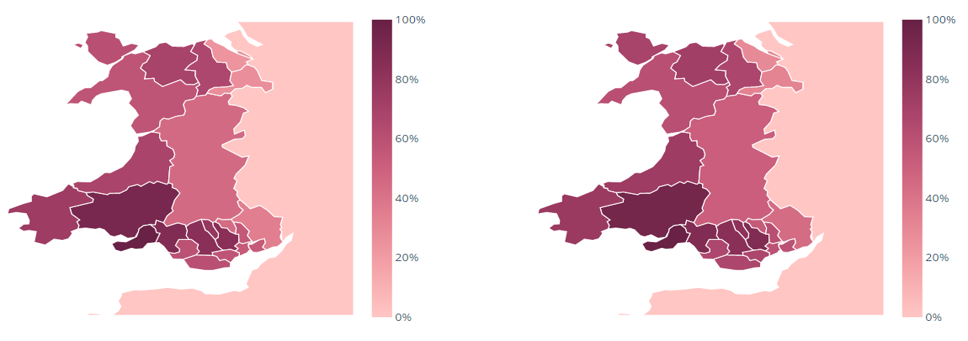
5 to 11 September 2021 and 12 to 18 September 2021.
Deaths per day
Projected to increase to around 15 per day over the next three weeks. Source: Modelled medium term projections, SAGE/SPI-M, 1 September.
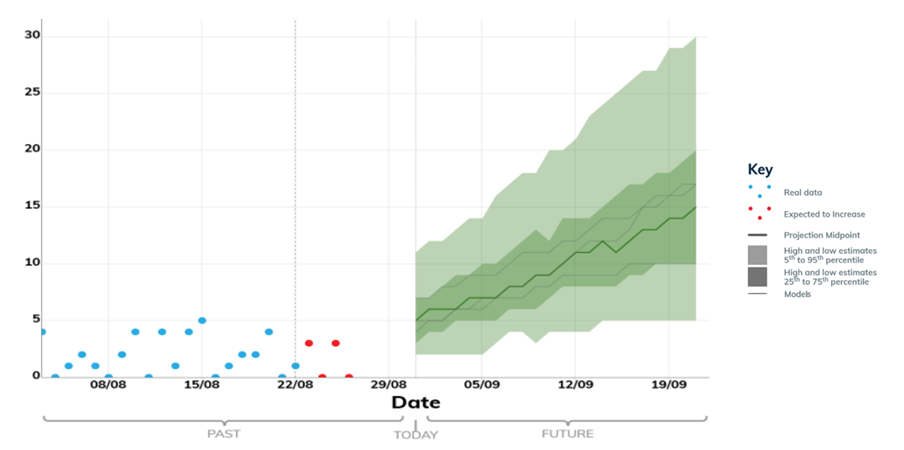
Data to 27 August 2021.
Hospitalisations per day
Projected to increase to more than 100 per day over the next three weeks. Source: Modelled medium term projections, SAGE/SPI-M, 1 September.
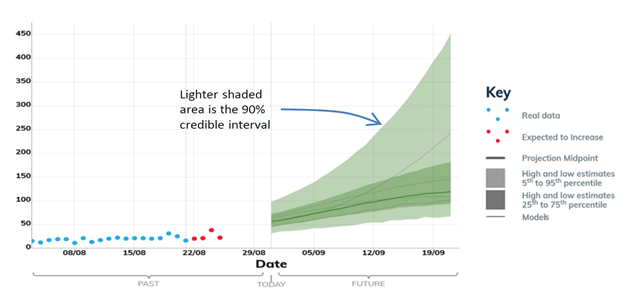
Data to 27 August 2021.
These projections are based on current trends and will not fully reflect the impact of policy or behavioural changes over the past two to three weeks, including the recent downward trend in all UK nations. The projections include the impact of vaccines, but cannot capture any future increases in transmission resulting from new variants. They are not forecasts or predictions.
Key risks and sources
Key risks
Transmissions, incidence and prevalence
Overall transmission of COVID-19 and test positivity has increased across Wales.
Rising trends across health boards and local authorities.
NHS capacity
From early-July 2021, COVID-19 pressure on the NHS has been generally increasing.
Mortality
Low, but slowly rising number of daily deaths in the most recent week.
Variants
Wales has 18,548 confirmed cases of the Delta variant (an increase of 2,096 from the previous week). Delta remains the dominant variant of COVID-19 in Wales.
Immunity and vaccines
4,539,655 (+26,926) doses of COVID-19 vaccine were given in Wales and recorded in the COVID-19 Welsh Immunisation System. Of this 2,355,999 (+12,628) were first doses and 2,183,656 (+14,298) were second doses. 88% of those aged 16 and over in Wales were estimated to have some immunity against COVID-19 infection at 28 August 2021.
International
There is an increase in traveller numbers this week. However the proportion of travellers testing positive is relatively low.
